DECEMBER KEY FIGURES
 |  | Dec '05 | Nov '05 to Dec '05 | Dec '04 to Dec '05 |  |
 |  | '000 | % change | % change |  |
|  |
| Short-term visitor arrivals |  |  |  |  |
 | Trend | 451.8 | -0.6 | -0.8 |  |
 | Seasonally adjusted | 454.3 | 2.7 | . . |  |
 | Original | 601.2 | . . | . . |  |
| Short-term resident departures |  |  |  |  |
 | Trend | 397.8 | 0.5 | 4.2 |  |
 | Seasonally adjusted | 408.0 | 3.6 | . . |  |
 | Original | 526.8 | . . | . . |  |
|  |
| . . not applicable |
Visitor arrivals, Short-term

| Resident departures, Short-term
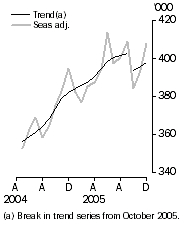
|
DECEMBER KEY POINTS
TREND ESTIMATES
- The trend estimate for short-term visitor arrivals to Australia during December 2005 (451,800 movements) decreased by 0.6% compared with November 2005. This followed monthly decreases of 0.3% for October 2005 and 0.4% for November 2005.
- Currently, short-term visitor arrivals are 1.3% lower than when the series last peaked in August 2005 (457,600 movements) and 0.8% lower than in December 2004.
- During December 2005, short-term resident departures (397,800 movements) increased by 0.5% compared with November 2005. This followed a monthly increase of 0.5% for November 2005.
- Currently, short-term resident departures are 1.2% lower than when the series last peaked in September 2005 (402,600 movements) after consecutive monthly increases from April 2003, and 4.2% higher than in December 2004. These changes were affected by a break in the trend series; see Explanatory Note 22.
SEASONALLY ADJUSTED ESTIMATES
- Seasonally adjusted estimates for short-term visitor arrivals during December 2005 (454,300 movements) increased by 2.7% compared with November 2005. This followed little change for October 2005 and a decrease of 3.6% for November 2005.
- Short-term resident departures for December 2005 (408,000 movements) increased by 3.6% compared with November 2005 and followed a monthly decrease of 6.0% for October 2005 and a monthly increase of 2.4% for November 2005.
ORIGINAL ESTIMATES
- In original movement terms, there were 601,200 short-term visitor arrivals to Australia and 526,800 short-term resident departures from Australia during December 2005.
NOTES
FORTHCOMING ISSUES
| ISSUE | Release Date |
| January 2006 | 7 March 2006 |
| February 2006 | 5 April 2006 |
| March 2006 | 9 May 2006 |
| April 2006 | 1 June 2006 |
| May 2006 | 6 July 2006 |
| June 2006 | 7 August 2006 |
EARLY ESTIMATES
Early estimates of short-term visitor arrivals for January 2005 will be available on the Australian Bureau of Statistics (ABS) web site on 17 February 2006. These estimates can be accessed by going to the ABS web site at <https://www.abs.gov.au>. Select All statistics - Access to all ABS products & statistics, then By Catalogue Number, then 3. Demography, then 34. Migration. Choose Short-term Visitor Arrival Estimates, Australia (cat. no. 3401.0.55.001).
DATA NOTES
This publication contains movement data. Care should be taken when interpreting this movement data as 'people'. See paragraph 5 of the Explanatory Notes for more detail.
The statistics in this publication have been rounded to the nearest 100 for short-term movements and to the nearest 10 for permanent and long-term movements. As a result, sums of the components may not add exactly to totals. Analysis featured in the Key Points and Main Features of this publication is based on unrounded data. Calculations made on rounded data may differ to those published.
CHANGES IN THIS ISSUE
There are no changes in this issue.
INQUIRIES
For further information about these and related statistics, contact the National Information and Referral Service on 1300 135 070 or Anne Ward on Canberra (02) 6252 6871.
MAIN FEATURES
INTERNATIONAL MOVEMENTS - 2005
In the year ended December 2005 there were a record 21.2 million crossings of Australia's international borders by travellers (original series). This represented 1,043 crossings per 1,000 Australian population. The majority of movements were short-term (97%). Short-term movements have a duration of stay in Australia or absence from Australia of less than one year. Twenty years ago (1985) there were 5.5 million crossings by travellers, representing 349 crossings per 1,000 Australian population.
Just over half of the total movements in 2005 were arrivals into Australia (10.7 million) and were comprised of 442,100 permanent and long-term arrivals, 4.7 million Australian residents returning after a short-term absence from Australia and 5.5 million visitors arriving for a short-term stay.
Just under half of the total movements in 2005 were departures from Australia (10.5 million) and were comprised of 251,700 permanent and long-term departures, 4.8 million Australian residents departing short-term and 5.5 million visitors departing Australia after a short-term stay.
A traveller may cross Australia's borders many times in a year and each movement is counted in these statistics. See the 3rd paragraph of the PERMANENT AND LONG-TERM MOVEMENTS section below.
SHORT-TERM VISITOR ARRIVALS
In trend terms, short-term visitor arrivals to Australia in December 2005 (451,800 movements) were 0.8% lower than in December 2004 and 0.6% lower than in November 2005. December 2005 was the fourth consecutive month in which this series declined. Short-term visitor arrivals are currently 1.3% lower than when the series last peaked in August 2005 (457,600 movements).
The following table presents the top ten source countries (based on original estimates) for short-term visitor arrivals during December 2005. Seasonally adjusted and trend estimates are also presented for these countries, along with the percentage change in trend compared with November 2005 and December 2004.
Short-term Visitor Arrivals, Major Source Countries - December 2005 |
|  |
 | Trend | Seasonally Adjusted | Original | Nov 05 to Dec 05 | Dec 04 to Dec 05 |  |
 | '000 | '000 | '000 | Trend % change | Trend % change |  |
|  |
| United Kingdom | 56.9 | 59.3 | 110.1 | -0.5 | -1.8 |  |
| New Zealand | 88.3 | 90.4 | 98.3 | -0.6 | -1.1 |  |
| Japan | 59.2 | 56.9 | 60.7 | -0.3 | -5.3 |  |
| United States of America | 35.3 | 36.6 | 44.3 | -1.1 | -3.8 |  |
| Singapore | 20.4 | 19.9 | 32.8 | -3.3 | -9.8 |  |
| China | 25.2 | 24.3 | 26.3 | 2.2 | 6.4 |  |
| Korea | 19.5 | 19.0 | 21.9 | -1.6 | 1.3 |  |
| Hong Kong | 13.4 | 14.5 | 19.2 | 0.3 | 7.8 |  |
| Malaysia | 13.8 | 14.1 | 17.7 | -0.4 | -7.2 |  |
| Germany | 12.1 | 12.1 | 15.7 | -1.2 | 0.3 |  |
|  |
SHORT-TERM RESIDENT DEPARTURES
In trend terms, short-term resident departures from Australia in December 2005 (397,800 movements) were 4.2% higher than in December 2004 and 0.5% higher than in November 2005. The series last peaked in September 2005 (402,600 movements). A trend break was introduced from October 2005 (see Explanatory Note 22).
The following table presents the top ten destinations (based on original estimates) for short-term resident departures during December 2005. Seasonally adjusted and trend estimates are also presented for these countries, along with the percentage change in trend compared with November 2005 and December 2004.
In original terms, short-term resident departures to Indonesia were ranked 4th in September 2005 and are now no longer in the top ten destinations for residents departing.
Short-term Resident Departures, Major Destinations - December 2005 |
|  |
 | Trend | Seasonally Adjusted | Original | Nov 05 to Dec 05 | Dec 04 to Dec 05 |  |
 | '000 | '000 | '000 | Trend % change | Trend % change |  |
|  |
| New Zealand | 69.1 | 68.2 | 109.5 | -0.5 | -1.3 |  |
| United States of America | 37.6 | 37.4 | 47.9 | 0.6 | 15.3 |  |
| United Kingdom | 33.7 | 38.6 | 39.1 | 1.0 | 8.1 |  |
| Thailand | 21.0 | 22.9 | 24.9 | 5.6 | 28.4 |  |
| Hong Kong | 14.7 | 14.7 | 21.5 | -3.2 | 2.0 |  |
| China | 19.1 | 16.5 | 20.5 | -2.7 | 8.8 |  |
| Fiji | 16.7 | 17.7 | 20.5 | 1.0 | 2.4 |  |
| Singapore | 16.8 | 17.1 | 19.5 | 0.9 | 10.0 |  |
| Viet Nam | 10.0 | 10.5 | 19.0 | -4.3 | 4.1 |  |
| Malaysia | 13.9 | 13.6 | 18.1 | 2.6 | 1.5 |  |
|  |
SHORT-TERM TRAVEL - THE YEAR 2005
Short-term visitor arrivals
In original terms, there were 5.5 million short-term visitor arrivals in Australia in the year ended December 2005. This was the highest number of arrivals recorded for a calendar year. In the year ended December 2004 there were 5.2 million visitor arrivals. Twenty years ago (1985), 1.1 million short-term visitors arrived in Australia.
TOTAL, Short-term Visitor Arrivals: Original Series - Calendar Years
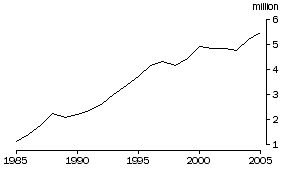
While the major source countries for short-term visitor arrivals have varied over the past twenty years, visitors from New Zealand, the United Kingdom and Japan have arrived in Australia in high proportions. The United States of America, while remaining in the top ten source countries, has shown variation. In 1985 arrivals from the United States of America accounted for 17% of all short-term movements (8% in 2005). Over the period short-term visitor arrivals from China and Korea have increased substantially.
The following table shows selected years for the top ten source countries (based on 2005) for short-term visitor arrivals.
Short-term Visitor Arrivals, Major Source Countries: Original Series - Calendar Years |
|  |
 |  | 1985 | 1995 | 2000 | 2005 |  |
|  |
| Countries as a proportion of total |  |  |  |  |  |
 | New Zealand (%) | 21.5 | 14.4 | 16.6 | 20.0 |  |
 | United Kingdom (%) | 13.4 | 9.3 | 11.8 | 12.9 |  |
 | Japan (%) | 9.4 | 21.0 | 14.6 | 12.5 |  |
 | United States of America (%) | 17.3 | 8.2 | 9.9 | 8.1 |  |
 | China (%) | 0.5 | 1.1 | 2.4 | 5.2 |  |
 | Singapore (%) | 3.1 | 5.4 | 5.8 | 4.8 |  |
 | Korea (%) | 0.3 | 4.5 | 3.2 | 4.6 |  |
 | Malaysia (%) | 2.9 | 2.9 | 3.1 | 3.0 |  |
 | Hong Kong (%) | 2.1 | 3.5 | 3.1 | 2.9 |  |
 | Germany (%) | 3.3 | 3.3 | 2.9 | 2.7 |  |
| Total ('000) | 1 142.6 | 3 725.8 | 4 931.4 | 5 497.0 |  |
|  |
Just over half of all short-term visitors to Australia in the year ended December 2005 stated the main reason for journey as holiday (54%) followed by visiting friends and relatives (20%) and business (10%). During this period the median age of short-term visitors was 39 years while the median duration of intended stay was 10 days.
New South Wales was the intended state of stay for 39% of all short-term visitors to Australia in the year ended December 2005. The other preferred destinations were Queensland (29%), Victoria (17%) and Western Australia (9%).
Short-term resident departures
In original terms, a record 4.8 million Australian residents travelled overseas for short-term visits during the year ended December 2005. This compared with 4.4 million in the year ended December 2004. Twenty years ago (1985), there were 1.5 million residents departing Australia short-term.
TOTAL, Short-term Resident Departures: Original Series - Calendar Years

New Zealand has remained the top destination for short-term residents departing during the years selected for comparison, and represented 18% of all movements in 2005. The United Kingdom is currently a less popular destination for residents departing Australia short-term than it was twenty years ago (9% in 2005 compared with 14% in 1985). Conversely, China has increased in popularity as a preferred destination (5% in 2005 compared with 1% in 1985).
The following table shows for selected years the top ten destinations (based on 2005) for short-term resident departures.
Short-term Resident Departures, Major Destinations: Original Series - Calendar Years |
|  |
 |  | 1985 | 1995 | 2000 | 2005 |  |
|  |
| Countries as a proportion of total |  |  |  |  |  |
 | New Zealand (%) | 18.5 | 14.7 | 15.1 | 17.6 |  |
 | United States of America (%) | 9.6 | 12.5 | 11.3 | 9.0 |  |
 | United Kingdom (%) | 14.0 | 10.5 | 9.7 | 8.5 |  |
 | Indonesia (%) | 6.6 | 8.8 | 8.0 | 6.7 |  |
 | China (%) | 1.5 | 2.1 | 2.7 | 4.9 |  |
 | Thailand (%) | 1.6 | 3.0 | 4.3 | 4.3 |  |
 | Fiji (%) | 5.4 | 3.0 | 2.1 | 4.1 |  |
 | Singapore (%) | 4.1 | 3.8 | 4.4 | 4.0 |  |
 | Hong Kong (%) | 6.6 | 6.2 | 4.4 | 3.9 |  |
 | Malaysia (%) | 2.7 | 3.5 | 3.9 | 3.4 |  |
| Total ('000) | 1 512.0 | 2 518.6 | 3 498.2 | 4 754.0 |  |
|  |
Just under half of all short-term residents departing Australia in the year ended December 2005 stated the main reason for journey as holiday (47%) followed by visiting friends and relatives (25%) and business (15%). The median age of all residents departing short-term was 41 years while the median duration of intended stay was 15 days.
As would be expected the most populous states were the largest contributors to short-term travel overseas in the year ended December 2005. Residents of New South Wales contributed the highest proportion of travellers (39%) followed by Victoria (24%), Queensland (17%), Western Australia (12%), South Australia (5%), the Australian Capital Territory (2%) and Tasmania and the Northern Territory (each 1%).
In terms of the rate of movement for short-term resident departures (the number of movements per 1,000 state or territory population) there was considerable variation across the states and territories. The Australian Capital Territory had the highest movement rate (302 movements per 1,000 population) followed by Western Australia (278), New South Wales (271), Victoria (229), the Northern Territory (204), Queensland (200), South Australia (144) and Tasmania (108). Overall the Australian movement rate was 234 short-term resident departures per 1,000 population.
PERMANENT AND LONG-TERM MOVEMENTS
There were 11,360 permanent (settler) arrivals to Australia during December 2005, an increase of 10.5% compared with December 2004 (10,280 movements). People born in the United Kingdom accounted for the largest proportion of settlers (16%), followed by people born in New Zealand (15%) and India and China (each 7%).
There were 6,300 Australian residents departing permanently from Australia during December 2005, an increase of 3.7% compared with December 2004 (6,070 movements).
Statistics on overseas arrivals and departures relate to the number of movements of travellers rather than the number of travellers. Therefore, care should be taken when using long-term movements data as it is known that some individuals who travel multiple times in a year are counted each time they cross Australia's borders (see paragraph 5 of the Explanatory Notes). Long-term movements in this publication are not an appropriate source of migration statistics. For further information refer to Australian Demographic Statistics (cat. no. 3101.0).
STATISTICAL SIGNIFICANCE
The above presentation of movements in estimates does not take into account whether the change in movement is statistically significant. Care should be taken when interpreting the impact of numeric and/or percentage change. Please see the Standard Errors section of this issue for more detail.
SEASONALLY ADJUSTED AND TREND ESTIMATES
INTRODUCTION
Seasonally adjusted and trend estimates add to the understanding of overseas arrivals and departures (OAD) statistics. Seasonally adjusted estimates allow users to analyse short-term movements including irregular impacts on the series, while trend estimates provide a better method to analyse and monitor the underlying direction of the short-term movement series. In most cases the trend series is the best source of information on the long-term direction of these statistics.
SHORT-TERM VISITOR ARRIVALS
Selected source countries
The graphs presented below illustrate the long-term increase in the trend series for arrivals from the United Kingdom and the recent decline in arrivals of short-term visitors from New Zealand. The graph for Japan shows the significant impact of Severe Acute Respiratory Syndrome (SARS) on the seasonally adjusted arrivals series in mid-2003.
United Kingdom
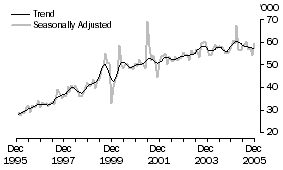 New Zealand
New Zealand
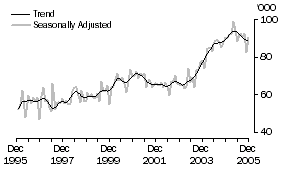 Japan
Japan
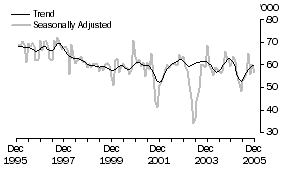
SHORT-TERM RESIDENT DEPARTURES
Selected destinations
For residents departing to the United States of America the graph illustrates the effect of the 11 September 2001 terrorist attacks in that country on short-term departures of Australian residents to the United States of America. The graph for New Zealand illustrates that departures of Australian residents, which had been experiencing strong growth since May 2003, have plateaued over recent months. For Indonesia the graph shows the impact of the 12 October 2002 Bali bombing and the reduced level of travel experienced in the next twelve months. The effect of the 1 October 2005 Bali bombing is also evident and a new break in the trend series has been introduced.
United States of America
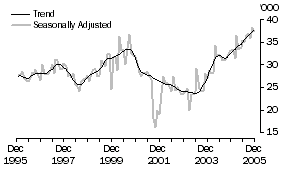 New Zealand
New Zealand
 Indonesia
Indonesia

 Print Page
Print Page
 Print All
Print All